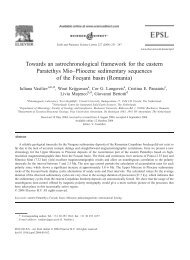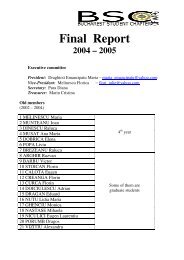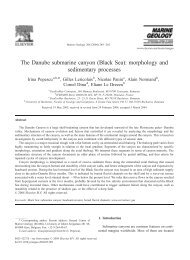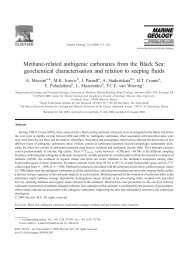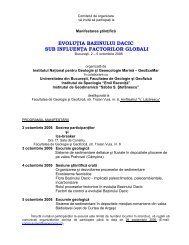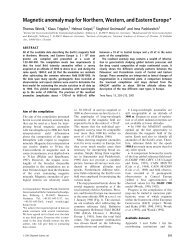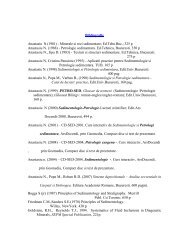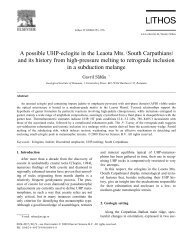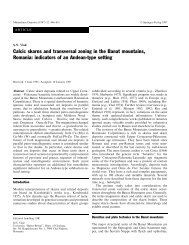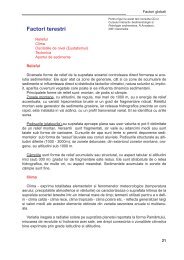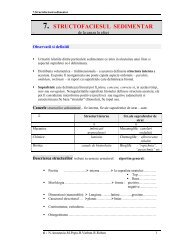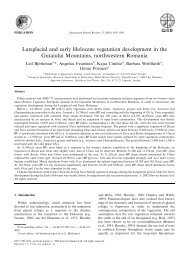Holocene vegetational history of the Apuseni ... - geo.edu.ro
Holocene vegetational history of the Apuseni ... - geo.edu.ro
Holocene vegetational history of the Apuseni ... - geo.edu.ro
You also want an ePaper? Increase the reach of your titles
YUMPU automatically turns print PDFs into web optimized ePapers that Google loves.
1478<br />
A. Bodnariuc et al. / Quaternary Science Reviews 21 (2002) 1465–1488<br />
Table 4<br />
Description <st<strong>ro</strong>ng>of</st<strong>ro</strong>ng> <st<strong>ro</strong>ng>the</st<strong>ro</strong>ng> local pollen assemblage zones in <st<strong>ro</strong>ng>the</st<strong>ro</strong>ng> Padis pr<st<strong>ro</strong>ng>of</st<strong>ro</strong>ng>ile<br />
LPAZ/Depth (cm) LPAZ name Main features <st<strong>ro</strong>ng>of</st<strong>ro</strong>ng> <st<strong>ro</strong>ng>the</st<strong>ro</strong>ng> LPAZ<br />
Pad. 12 5–11<br />
Poaceae–Fagus–Picea–Carpinus–Corylus–Quercus<br />
Small decrease in Poaceae, Picea and Carpinus, slight increase<br />
in Fagus, Quercus, Corylus and Pinus<br />
Pad. 11 11–15 Poaceae–Fagus–Picea–Carpinus–Cerealia Decrease in Poaceae and synch<strong>ro</strong>nous increase in Fagus, Picea,<br />
Carpinus, Quercus and Pinus<br />
Upper limit: decrease in Poaceae, increase in Fagus<br />
Pad. 10 15–20 Poaceae–Fagus–Picea–Cerealia Abrupt increase in Poaceae and synch<strong>ro</strong>nous decrease in Fagus<br />
and Picea. Cerealia, Plantago, Rumex and Chenopodiaceae well<br />
represented,<br />
Upper limit: decrease in Poaceae, increase in Fagus and Picea<br />
Pad. 9 20–25 Fagus–Poaceae–Picea–Corylus–Quercus Increase in Picea, decrease in Quercus, slight increase in Fagus,<br />
decrease in Chenopodiaceae<br />
Upper limit: increase in Poaceae, decrease in Fagus and Picea<br />
Pad. 8 25–30 Fagus–Poaceae–Picea Decrease in Picea and Abies, increase in Quercus and Betula,<br />
Poaceae, Chenopodiaceae, Rumex, Plantago and Cerealia<br />
Upper limit: slight increase in Fagus and Picea, decrease in<br />
Chenopodiaceae<br />
Pad. 7 30–40 Fagus–Picea–Abies Fall in Carpinus, decline in Fagus, increase <st<strong>ro</strong>ng>the</st<strong>ro</strong>ng>n decline in Picea<br />
and Abies. Increase in Chenopodiaceae at <st<strong>ro</strong>ng>the</st<strong>ro</strong>ng> end <st<strong>ro</strong>ng>of</st<strong>ro</strong>ng> <st<strong>ro</strong>ng>the</st<strong>ro</strong>ng> phase<br />
Upper limit: decline in Picea and Abies, increase in Poaceae and<br />
Chenopodiaceae<br />
Pad. 6 40–50 Fagus–Picea–Carpinus–Poaceae–Abies Optimum <st<strong>ro</strong>ng>of</st<strong>ro</strong>ng> Fagus, small variations in Picea and Carpinus and<br />
increase in Poaceae and Corylus. Small increase in Artemisia<br />
Upper limit: decrease in Fagus and Carpinus, increase in Picea<br />
and Abies<br />
Pad. 5 50–55 Fagus–Picea–Carpinus–Abies Increase in Picea, Carpinus and Chenopodiaceae. Small<br />
decrease in Abies and small increase in Fagus<br />
Upper limit: decrease in Carpinus and Picea, increase in<br />
Poaceae<br />
Pad. 4 55–70 Fagus–Picea–Abies–Carpinus Small increase in Abies and Fagus, fluctuations <st<strong>ro</strong>ng>of</st<strong>ro</strong>ng> Carpinus and<br />
Corylus, small increase in Chenopodiaceae. Beginning <st<strong>ro</strong>ng>of</st<strong>ro</strong>ng> <st<strong>ro</strong>ng>the</st<strong>ro</strong>ng><br />
AP/T decline at <st<strong>ro</strong>ng>the</st<strong>ro</strong>ng> end <st<strong>ro</strong>ng>of</st<strong>ro</strong>ng> <st<strong>ro</strong>ng>the</st<strong>ro</strong>ng> phase<br />
Upper limit: Increase in Picea, Carpinus and Chenopodiaceae<br />
Pad. 3 70–80 Corylus–Carpinus–Fagus–Picea–Abies Decrease in Corylus, Carpinus Ulmus. Increase in Abies, Fagus<br />
and Picea. Small increase in Juglans<br />
Upper limit: decrease in Carpinus, small increase in Corylus<br />
Pad. 2 80–85 Corylus–Carpinus–Picea–Fagus Decrease in Corylus and increase in Carpinus and Fagus. Small<br />
increase in Quercus and Abies. Presence <st<strong>ro</strong>ng>of</st<strong>ro</strong>ng> Juglans<br />
Upper limit: increase in Abies and Fagus, decrease in Corylus<br />
and Carpinus<br />
Pad. 1 85–90 Corylus–Picea–Poaceae Increase in Corylus,decrease in Poaceae. Carpinus, Fagus and<br />
Abies present but rare<br />
Upper limit: decrease in Corylus, increase in Carpinus and<br />
Fagus<br />
F<strong>ro</strong>m RPAZ 5–9 (ca 6450 cal BP–Present), <st<strong>ro</strong>ng>the</st<strong>ro</strong>ng> pollen<br />
diagrams <st<strong>ro</strong>ng>of</st<strong>ro</strong>ng> Bergerie, Padis and Cimeti"ere can be<br />
compared.<br />
At Padis, between 4650 and 4100 cal BP, in <st<strong>ro</strong>ng>the</st<strong>ro</strong>ng> upper<br />
part <st<strong>ro</strong>ng>of</st<strong>ro</strong>ng> RPAZ 5, <st<strong>ro</strong>ng>the</st<strong>ro</strong>ng> percentages <st<strong>ro</strong>ng>of</st<strong>ro</strong>ng> Carpinus are low<br />
(2%) when comparing with Bergerie (near 5%) and<br />
Cimeti"ere (near 10%). At Padis, Cimeti"ere and Bergerie,<br />
<st<strong>ro</strong>ng>the</st<strong>ro</strong>ng> increase in Fagus and Carpinus and <st<strong>ro</strong>ng>the</st<strong>ro</strong>ng> synch<strong>ro</strong>nous<br />
decrease in Corylus characterise <st<strong>ro</strong>ng>the</st<strong>ro</strong>ng> beginning <st<strong>ro</strong>ng>of</st<strong>ro</strong>ng> <st<strong>ro</strong>ng>the</st<strong>ro</strong>ng><br />
RPAZ 6 dated ca 4500 cal BP (4050780 BP) at Bergerie.<br />
This age, d<st<strong>ro</strong>ng>edu</st<strong>ro</strong>ng>ced f<strong>ro</strong>m that <st<strong>ro</strong>ng>of</st<strong>ro</strong>ng> levels 160–155 f<strong>ro</strong>m<br />
Bergerie (4050780 BP), was preferred to that <st<strong>ro</strong>ng>of</st<strong>ro</strong>ng> <st<strong>ro</strong>ng>the</st<strong>ro</strong>ng><br />
bottom <st<strong>ro</strong>ng>of</st<strong>ro</strong>ng> Padis (4595765 BP, 5300 cal BP) for three<br />
reasons: at Padis <st<strong>ro</strong>ng>the</st<strong>ro</strong>ng> thickness <st<strong>ro</strong>ng>of</st<strong>ro</strong>ng> <st<strong>ro</strong>ng>the</st<strong>ro</strong>ng> sample is 15 cm<br />
and at Bergerie only 5 cm; at Padis <st<strong>ro</strong>ng>the</st<strong>ro</strong>ng> dated sediment<br />
concerns material situated below <st<strong>ro</strong>ng>the</st<strong>ro</strong>ng> beginning <st<strong>ro</strong>ng>of</st<strong>ro</strong>ng> <st<strong>ro</strong>ng>the</st<strong>ro</strong>ng><br />
Fagus curve; comparison between <st<strong>ro</strong>ng>the</st<strong>ro</strong>ng> dates obtained for<br />
<st<strong>ro</strong>ng>the</st<strong>ro</strong>ng> Fagus expansion at Bergerie (4050780 BP) and in<br />
<st<strong>ro</strong>ng>the</st<strong>ro</strong>ng> southwestern Carpathians, in Banat mountains<br />
(3880760 BP; R.osch and Fischer, 2000), are close to<br />
4500 cal BP.<br />
The beginning <st<strong>ro</strong>ng>of</st<strong>ro</strong>ng> RPAZ 7 corresponds to <st<strong>ro</strong>ng>the</st<strong>ro</strong>ng> Abies<br />
development dated ca 4200 cal BP (3720760 BP) at<br />
Bergerie. The end <st<strong>ro</strong>ng>of</st<strong>ro</strong>ng> RPAZ 7 is not dated. The p<strong>ro</strong>posed<br />
limit at 1940 cal BP is based on an interpolation between<br />
<st<strong>ro</strong>ng>the</st<strong>ro</strong>ng> radiocarbon dating <st<strong>ro</strong>ng>of</st<strong>ro</strong>ng> Bergerie (3720760 and



